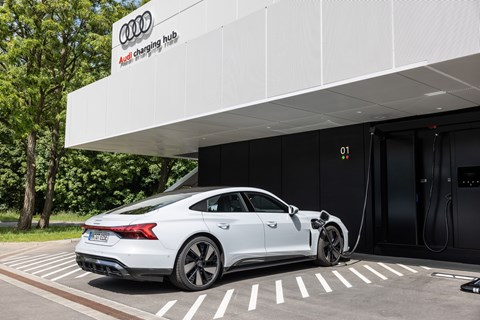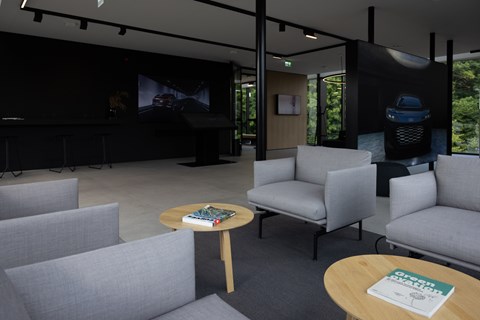► First hub in Nuremburg
► Uses the mains along with second-life storage and solar panels
► Six charges in total, and 2.45mWh stored underground
Electric cars are being bought in increasing numbers in 2023, but they’re coming with increasing growing pains when it comes EV adoption. Alongside range and cost, infrastructure remains a stumbling block for many customers – especially during peak demand. In response, OEMs are now rolling out their own charging networks, designed to ease EV owners into an electric lifestyle, while giving them a more premium experience than your average service station.
In Germany just 15 per cent of electric charging is used on average, the majority of that all comes at the same time in the day. This is Ingolstadt’s solution to the peak, charging issue. It’s called the charging hub, and it’s a purpose-built, premium but highly modular charging facility, designed to relieve peak pressure during high demand.
Best public EV charging network
Audi electric cars: what you need to know
When will the EV chargers come to the UK?
Audi’s charging plans are less firm than those of their Mercedes’ rival, but there are tentative plans for expansion. A facility in Zurich will follow the Nuremburg site, though it’ll more compact and use a slightly different combination of Audi’s modular building blocks.

After that, two sites will open in Berlin and Salzburg this year, with a further three penned in for next year – though the location of them is yet to be confirmed. It’s a very different strategy to Mercedes, who has already pledged $1billion on the North American arm of its charging network.
Where are Audi’s EV charging stations going to be located?
Audi believes that most charging demands take place just outside of cities, and it’s also an area where there’s more space to create more spacious, luxurious environments. We wouldn’t rule out charging stations along the motorway or autobahn, but the EV charging station we visited was on the outskirts of town.
What are the electric charges specs?
CAR magazine poked around the first hub in Ingolstadt, and it’s everything you’d expect from the four rings. Located just out of town, it’s mixture of aluminium and glass, designed to look permanent even if it’s relatively easy to construct. We’re told that the average time taken to build in Nuremburg is six months, but the charging hub took just 11 months to plan, five weeks to get planning permission and a month to build.

The ground floor features six 320kW fast chargers in total, with large charging arms making it easy to plug in whichever way you park. However, below that you’ll find 2.45MWh of electricity stored in second-life batteries – roughly equivalent to 26 eTron 55s batteries.
It’s this feature which makes the hub versatile, and why it’s relatively quick to plan. Much like a rain bucket the hub has its own reservoir of power, so it can easily cope with peak demand while using a standard 200kW connection to the grid. Solar panels on the roof also generate an additional 30kW (in prime weather) adding to the second-life bucket.
In all, this extra buffer of power means the hub has can charge 6 vehicles simultaneously, and cope with a peak demand throughput of up to 80 vehicles.
How does the reservation system work?
The service in Nuremburg uses a reservation system to flatten demand, with each customer booking a 45-minute slot before arriving and unlocking their designated bay. The charging area of the hub is brand agnostic, though we’re told around 50 per cent of customers are Audi owners, with 18 per cent Tesla disciples. Audi customers are allowed to the second floor, where there are a range of services such as tea, coffee and toilets – thought this could be opened up to owners of other brand EVs.

It seems to be working too; between January and April this year, the hub registered over 3100 charges with an average of 24 charges at 800kWh per day. 35 customers entered the premium second floor every day, and 60% of all customers use the hub more than once a week.
Why just Audi?
Audi’s premium position in the VW Group dictates that its charging hubs push a posh, design focused experience but it’s possible we’ll soon see similar charging hubs from other VW Group brands – and they may focus on other aspects such as affordability or scale.